History
History of the Institute of Physiology and Pathophysiology in Erlangen
Written by Prof. Dr. med. Dr. h.c. Karl-Heinz Plattig
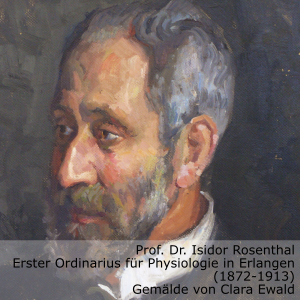 Physiology is taught in Erlangen since the founding of the Friedrich-Alexander-University on 4.11.1743. Anatomists started these ‘teachings of the functional life forms’ because they were no longer satisfied with investigating only the static structure of humans and animals. This marks a revival since the time of Hippocrates and the antique ‘Physiologus’ and is manifested with the publication of ‘Exercitatio anatomica de motu cordis et sanguinis in animalibus’ (Anatomical essay about the movement of heart and blood in animals) by William Harvey in 1628. In this essay Harvey reports impressively simple experiments that prove blood to be flowing in a closed circuit – thereby defeating the academic opinion at the time of blood being constantly produced in the liver and ‘used up’ in the tissues.
Physiology is taught in Erlangen since the founding of the Friedrich-Alexander-University on 4.11.1743. Anatomists started these ‘teachings of the functional life forms’ because they were no longer satisfied with investigating only the static structure of humans and animals. This marks a revival since the time of Hippocrates and the antique ‘Physiologus’ and is manifested with the publication of ‘Exercitatio anatomica de motu cordis et sanguinis in animalibus’ (Anatomical essay about the movement of heart and blood in animals) by William Harvey in 1628. In this essay Harvey reports impressively simple experiments that prove blood to be flowing in a closed circuit – thereby defeating the academic opinion at the time of blood being constantly produced in the liver and ‘used up’ in the tissues.
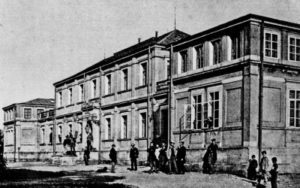
At the university’s founding, the winter semester of 1743/44, the medical faculty comprised 5 professors, each of whom contributed to the teaching of Physiology. Among many other medical and natural science courses, Schmidel taught ‘Physiology after Boerhave Pathology & Semiotics’. After 1749 he also performed sections (see Engelhardt 1843). Physiology at the time was only a side discipline and was surely not in the focus of research as today.
Our discipline first became an independent chair with the appointment of the first full physiologist, Isidor Rosenthal (1836-1915) in 1872. Rosenthal had previously worked many years as assistant to the famous Berlin physiologist Emil du Bois-Reymond. He started his work in Erlangen as professor of Physiology and initially also of Hygiene at the same building, that our institute resides in today. The building hat 9 years before been commissioned by anatomist and physiologist Joseph von Gerlach as the university’s first new building at the ‘Schlossgarten’ park’s south side and to this day is sometimes called ‘second’ or ‘old anatomy building’.
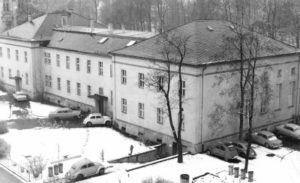
After tough negotiations, Rosenthal got the university to renovate the building for the Institute of Physiology’s needs. For that from 1897 until 1903, his chair transitionally moved to the hitherto ‘Delivery clinic’ – the area that today houses the Institute of Pathology.
Amongst Rosenthal’s many scientific achievements, the most notable is the tablet press, which was in part developed in Berlin and brought to Erlangen with him in 1872. This was a critical innovation for the pharmacological industry at the time. Rosenthal also served as physician to the troops in the war between Germany and France in 1871 and was awarded the Iron Cross on White Ribbons. In Erlangen, he not only contributed to the scientific community, but also as politician and member of the city council. As hygienist, he supported the founding of a communal bath with tubs and showers ‘for the poor’, the slaughter house, the Pauli-Fountain at the market square and of the ‘Sekundärbahn’ train line between Erlangen and Gräfenberg.
Rosenthal’s successor was Ernst Winland (1869-1932), wo was appointed on 1.10.1913. In the later years, he was deputized by the Institute’s custodian Kurt Groß (1887-1969) and retired on 1.8.1932. After 1.10.1932 Richard Wagner (1893-1970) became head of the Institute, but was shortly later appointed to Breslau (today Worclaw) und the worked in Munich after 19491. His successor was Rupprecht Matthaei (1895-1976), appointed on 1.4.1935. Deemed ‘ardent supporter’ (he was a NSDAP member since 1931), he was discharged by the US military government on 6.6.1945. His license to teach was reinstated in 1951. He was appointed to the new found chair ‘Professor of Physiology for Psychologist’ an 1.1.1956 and retired on 1.6.1961. Otto F. Ranke (1899 – 1959) became interim director if the institute on 1.5.1946 but was already discharged by the military government three month later. He became a full professor and director of the Institute on 16.9.1947 and died in 1959.
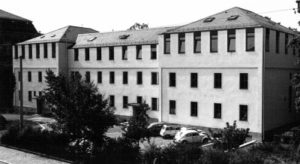
Ranke gave rise to the era of physiology of the sensory and of the central nervous system: In Basel, Heidelberg and Munich, he learnt from Philipp Broemser, who was focused on the cardiovascular system. Ranke’s name today is still associated with pulse waves and certain physical properties of the expansion tank. Ranke applied these technical descriptions of the pulse wave were applied to the liquids of the inner ear, leading to the conception of the famous ‘travelling wave theory’. This theory describes the frequency mapping onto the cochlea basilary membrane and was proven by Georg von Békesy in ingenious experiments, for which he was awarded with a nobel prize in 1961 – two years after Ranke’s death. His successor W.D. Keidel wrote a eulogy (in German) that was published in ‘Ergebnisse der Physiologie’.
It was only in the spring of 2016 that the institute gained knowledge of Ranke’s work on the military uses of the stimulant Previtin, he conducted during hist time at the Institute of Aviationphysiologie (director Hubertus Strughold) at the Berlin Military Medical Academy. Previtin (N-Metamphetamine, today also known as ‘Crystal Meth’) was freely available until 1941. It suppresses fatigue, hunger and pain, it boosts performance and concentration, it causes euphoria and can lead to addiction very quickly. The extensive use of Previtin is said to have facilitated Hilter’s success in the blitz against Poland and France in 1939/1940. Although Ranke describes Previtin as ‘valuable tool to break fatigue in exceptional situations, at least in leaders’ in his 1040 report, he also highlighted ‘potential long-term harm due to abuse’ and demanded a medical oversight of Previtin administration (see Bundesarchiv RH 12-23/1882).
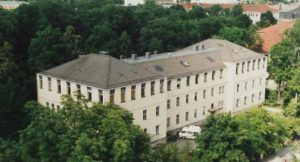
Ranke’s successor Wolf D. Keidel (director 1961 – 1986) is responsible for transferring the pulse wave theory from mechanical theories to electro physiology. He also led the way in ultrasonic diagnostics. At the start of 1965, he initiated the creation of a second chair, today known as ‘Institute of cellular and molecular Physiology’ and lead by Prof. Dr. Christoph Krombacher. This duplication of Chair and Institute was the first in the German history of academia. At first, many colleagues did not understand and strongly criticized this decision, but it quickly became common throughout German-speaking countries.
Hermann O. Handwerker (director 1986-2006) focused the Institute’s attention on pain that was intensively investigated from the level of its receptors with molecularbiological methods all the way up to its central projections with modern imaging methods. On top of his work as the Institute’s director and his scientific work, he was (and still is) highly motivated to improve teaching at the Institute. He was a speaker on many occasions and some of his speeches were published in the Proceedings of the Physical-Medical Society Erlangen and can be viewed here (in German, with friendly permission by Publisher Palm and Enke).